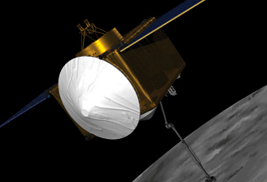
OSIRIS-REx
About
Origins, Spectral Interpretation, Resource Identification, Security, Regolith Explorer
OSIRIS-REx launched from the Cape Canaveral Air Force Station in Florida on Sept. 8, 2016. It arrived at Bennu on Dec. 3, 2018, and began orbiting the asteroid Bennu for the first time on Dec. 31, 2018. On October 20, 2020, OSIRIS-REx made history for NASA when it tagged the surface of asteroid Bennu for 4.7 seconds, triggering a flush of nitrogen gas and collecting the largest sample of extraterrestrial material since the Apollo moon landings. In preparation for the sample collection, the spacecraft had spent two years photographing and mapping the asteroid in tremendous detail. The spacecraft successfully dropped its sample return capsule to return to Earth on Sept. 24, 2023.
The OSIRIS-REx mission seeks answers to questions that are central to the human experience: Where did we come from? What is our destiny? OSIRIS-REx is going to Bennu, a carbon-rich asteroid that records the earliest history of our Solar System, and bringing a piece of it back to Earth. Bennu may contain the molecular precursors to the origin of life and the Earth’s oceans. Bennu is also one of the most potentially hazardous asteroids. It has a relatively high probability of impacting the Earth late in the 22nd century. OSIRIS-REx will determine Bennu’s physical and chemical properties. This will be critical for future scientists to know when developing an impact mitigation mission. Finally, asteroids like Bennu contain natural resources such as water, organics, and precious metals. Future space exploration and economic development will rely on asteroids for these precious materials. Asteroids may one day fuel the exploration of the Solar System by robotic and manned spacecraft.
Faculty
OSIRIS-REx Faculty

Erik Asphaug
Professor
Lunar Studies, Planetary Analogs, Planetary Geophysics, Planetary Surfaces, Small Bodies, Theoretical Astrophysics, Titan & Outer Solar System
Jessica Barnes
Associate Professor
Cosmochemistry, Lunar Studies, Planetary Analogs
William Boynton
Professor Emeritus
Astrobiology, Cosmochemistry, Lunar Studies, Small Bodies
Dani Mendoza DellaGiustina
Assistant Professor, Deputy Principal Investigator, OSIRIS-REx, Principal Investigator, OSIRIS-APEX
Earth, Photogrammetry, Planetary Analogs, Planetary Geophysics, Planetary Surfaces, Small Bodies
Pierre Haenecour
Assistant Professor
Astrobiology, Cosmochemistry, Planetary Astronomy, Small Bodies
Ellen Howell
Research Professor
Small Bodies
Dante Lauretta
Director, Arizona Astrobiology Center, Principal Investigator, OSIRIS-REx, Regents Professor
Astrobiology, Cosmochemistry, Small Bodies
Renu Malhotra
Louise Foucar Marshall Science Research Professor, Regents Professor
Astrobiology, Exoplanets, Orbital Dynamics, Planetary Formation and Evolution, Small Bodies, Theoretical AstrophysicsOther Researchers
OSIRIS-REx Researchers

Matthew Chojnacki
DCC Associate Research (McEwen)
Photogrammetry, Planetary Surfaces, Small Bodies
Ruby Fulford
PTYS Graduate Student
Astrobiology, Planetary Geophysics, Planetary Surfaces, Small Bodies, Titan & Outer Solar System
Dathon Golish
Mission Instrument and Observation Scientist
Photogrammetry, Small Bodies
Kana Ishimaru
PTYS Graduate Student
Cosmochemistry, Small Bodies
Robert Melikyan
PTYS Graduate Student
Orbital Dynamics, Small Bodies
Beau Prince
PTYS Graduate Student
Cosmochemistry
Bashar Rizk
Research Scientist/Senior Staff Scientist, OSIRIS-APEX/OCAMS
Asteroid Surveys, Planetary Atmospheres
Andrew Ryan
Researcher/Scientist, OSIRIS-REx, OSIRIS-APEX
Planetary Surfaces
Stephen Schwartz
DCC Associate Staff Scientist (Asphaug)
Orbital Dynamics, Planetary Astronomy, Planetary Surfaces, Small Bodies, Space Situational Awareness
Sarah Sutton
Photogrammetry Program Lead, HiRISE, Researcher/Scientist
Earth, Lunar Studies, Photogrammetry, Planetary Analogs, Planetary Surfaces, Small BodiesSupport Staff
OSIRIS-REx Support Staff

Kris Becker
Senior Data Analyst, OSIRIS-APEX
Photogrammetry
Carina Bennett
Project Manager and Software Engineer, SAMIS

Denise Blum
Business Manager, OSIRIS-REx, OSIRIS-APEX

Christian d'Aubigny
DCC Deputy Instrument Scientist, OCAMS (Byrne)

Tony Ferro
System Administrator, OSIRIS-REx, OSIRIS-APEX/SPOC

Michael Fitzgibbon
Software Engineer, Lead Calibration & Validation, OSIRIS-REx, OSIRIS-APEX

Andrew Gardner
Systems Programmer, Principal

Damian Hammond
Software Engineer, OSIRIS-REx, OSIRIS-APEX Telemetry Processing

Dolores Hill
Research Specialist, Senior
Cosmochemistry, Small Bodies
Joshua Kantarges
SAMIS Software Engineer, OSIRIS-REx









